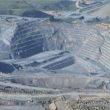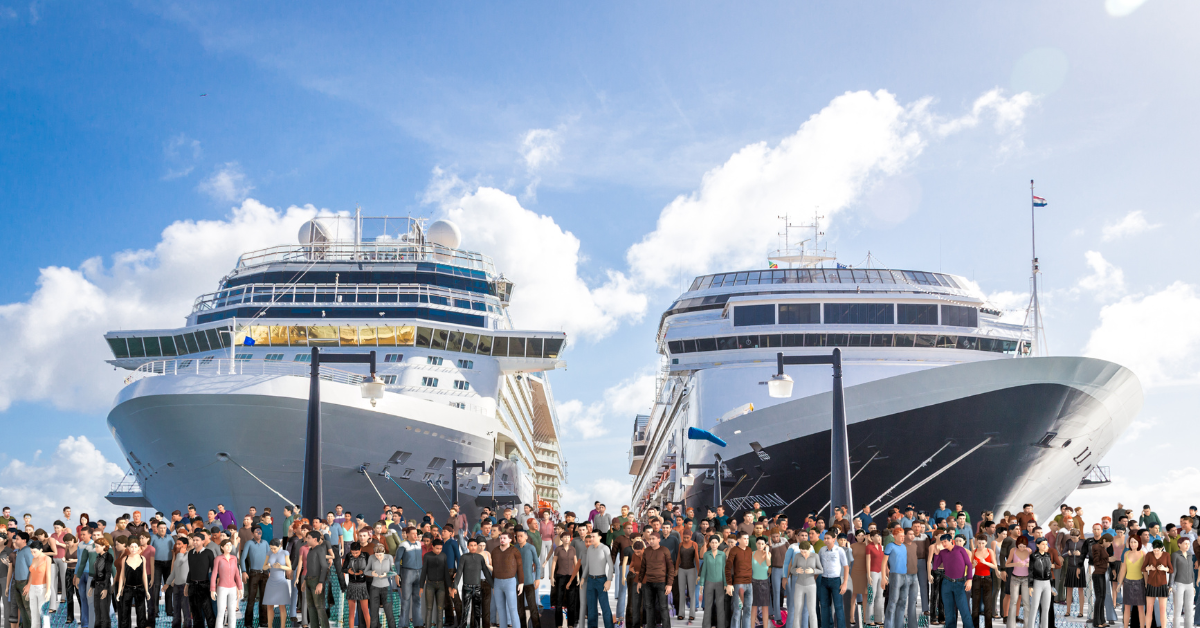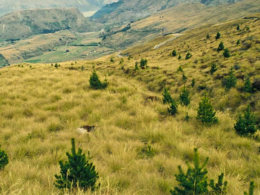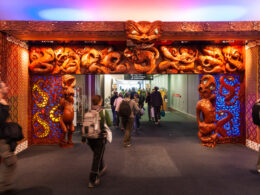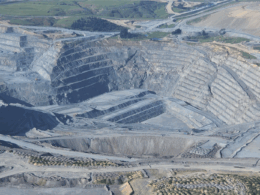Last week the first cruise ships of the new season arrived back into New Zealand ports. The New Zealand media tend to mark the return of cruise ships with excitement. But many are unhappy about cruise ships visiting their port communities. So what are the issues – and why are views so divided?
The new cruise season has started. The Cruise Association of New Zealand reports that last week various cruise ships were back in New Zealand ports including the Diamond Princess, Celebrity Solstice, Pacific Explorer and Crown Princess. The names of these cruise ships always amuse me – how many variations can there be of words like ‘princess, celebrity, crystal, harmony, symphony and diamond’?
Usually the media get very excited about the first cruise ships coming back at the start of the new season. This was particularly the case after the COVID enforced tourism pause. I remember Hilary Barry and the TVNZ crew setting up their outdoor furniture set on the wharf in Auckland to excitedly speak to rather surprised cruise passengers who were stepping ashore to a red carpet welcome, and fanfare usually reserved for dignitaries, celebrities and royalty.
Interestingly, the return of the first cruise ships last week also marked the start of an organised campaign of protests in a number of New Zealand port destinations. The protests are organised by Climate Liberation Aotearoa to highlight the problematic issue of luxury emissions during a climate crisis. Stuff reported on the 22 October that “cruise ships arriving in New Zealand this season can expect to be met by protesters”. The Diamond Princess was met by protesters when it docked at Auckland, Wellington, Lyttleton and Dunedin.
In Dunedin cruise passengers hoping to take a photograph of the iconic railway station would have been challenged to avoid an enormous banner that was dangled from the upstairs balcony. It read “They Cruise We Lose”. Protesters also handed out leaflets, held banners and spoke through megaphones. Back in Port Chalmers, when returning to their ship, protesters slowly crossed the pedestrian crossing in front of bus-loads of passengers. And in a final send off – two people on paddleboards saw passengers off holding up banners on the harbour.
****
The views of the protesters are abundantly clear – that the disruption to the environment and climate caused by cruise ships that function as floating resorts can not be justified.
The protesters aim to achieve three things:
- For councils to mitigate cruise ship emissions by putting them into local carbon budgets.
- For ratepayers to stop subsiding cruise ships. In Dunedin, 358 extra bus trips are put on to accommodate cruise passengers each day. “That means eight extra buses funded by the ratepayers for cruise ship passengers. And that means that rate payers are subsidising a form of tourism that contributes very little to the local economy and damages the environment.
- Thirdly, that cruise visits to sensitive natural areas including Antarctica and Piopiotahi Milford Sound end.
****
The Cruise Association of New Zealand was invited to comment and chief executive Jacqui Lloyd made five points in response to the protesters.
- The protesters are targeting the wrong group – they should be targeting the cruise industry rather than passengers who have long dreamed of coming to New Zealand.
- That the cruise association actually supports calls for the Climate Change Commission to include cruise emissions in 2050 net zero targets.
- That compared to other forms of international marine traffic such as cargo and ferries the cruise sector is actually quite small with 323 ships worldwide.
- That comparison with point of point transport such as aviation ignores the fact that cruise ships incorporate the overall holiday – including hotel accommodation.
- And finally, that cruise lines themselves over the last 10-15 years have made enormous investments into new technologies including the capacity to plug in to clean shore power supply so they can turn their engines off while in port.
So what are we to make of these comments in terms of a commitment to sustainable tourism in New Zealand. Here are my short responses to each of these five comments:
First, protesters are clearly targeting the right group for two reasons; firstly protesters have access to passengers because it is the passengers who are visiting communities where concerns are deep enough to justify organised protest action. The problem with cruise from an industry point of view is that it is faceless. How do local protesters make their views known to cruise executives behind high security glass doors in high rise executive offices in Florida? Particularly if these companies engage in greenwashing and putting corporate profits ahead of the environment and local communities. Related to this, we have long been told that consumers have the power for change, and that we should harness the power of consumers. It therefore makes sense to target passengers to raise awareness of climate concerns.
Second, credit to the cruise association if it supports calls for the Climate Change Commission to include cruise emissions in 2050 net zero targets, but with what conditions? The cruise association does not want New Zealand to be more ambitious than other countries in efforts to decarbonise maritime transportation because of the global nature of the fleet. And what about much needed 2030 targets? We know that falling back to 2050 is delaying the urgent action that is needed today.
Third, the fact that cruise is small relative to other forms of international maritime transport is completely irrelevant. That is like saying that New Zealand does not need to decarbonise because we have a small population and therefore an insignificant contribution relative to China. This is a line of argument that was buried many years ago, although some still cling to it. On most counts cruise ships are more environmentally damaging than other vessels in the global fleet like container ships, bulk carriers, passenger ferries and fishing vessels. This suggest more rather than less urgency to tackle the environmental impacts of cruise.
Fourth, arguing that cruise should not be compared with point-to-point transport is problematic. Cruise ships do provide most or all elements of the ‘overall holiday’ including food and beverage, entertainment and accommodation. But on all of these counts cruise usually comes out worse in terms of environment costs, including waste, energy and emissions.
Fifth, if it is the case that cruise companies have been investing in technologies then that is creditworthy, but investment in technology is a means not an end – it is a distraction if levels of waste, air pollution and emissions remain at unacceptable levels. Ultimately it is results that count.
Jackie Lloyd makes the comment that some cruise ships can plug into shore power so that they can turn their engines off while in port. In doing so highlights theproblem that in New Zealand ports don’t have any plug-in facilities for shore to ship power supply. In fact no ports in the southern hemisphere have short power supply capacities, although Sydney is seeking to the be first, at the cost of $60 million Australian dollars. So it is not cheap.
Which raises the question – who pays? Is it the local port authorities, perhaps through local rates (in other words local residents) – or should cruise companies and their passengers meet this cost? And should New Zealand be committing its limited renewable energy supply to luxury cruise when we have an energy supply shortage that the current government has used to justify reopening oil, gas and coal supply? Interestingly, some UK and European ports now provide shore power supply. Only to find that cruise companies refuse to use it because it is cheaper to continue to burn cheap and dirty onboard fuel rather than pay for shore power supply. Oh dear.
What should we make of this stand-off? From a sustainable tourism point of view the answers are clear. Cruise is a form of enclave tourism – this is a term that arose in the 1970s in association with luxury tourism resorts that were developed in the most beautiful tropical island destinations. These so-called enclaves were largely or entirely segregated from local communities. Cruise tourism is the same in that it is almost completely removed from host community wishes as expressed now in Destination Management Plans.
Those Destination Management Plans, which are now in place for all 31 regions in New Zealand, recognise that host community sentiment is critically important to sustainable tourism. Tourism Industry Aotearoa refer to this as ‘social licence to operate’. Clearly cruise tourism’s social licence is very tenuous when local residents start to actively protest against it. This should be an enormous concern. When host sentiment sours it is hard to restore. The Cruise Association of New Zealand should find ways to engage constructively rather than dismissively.
I would also add that the state of journalism relating to cruise tourism leaves much to be desired. The Cruise Association of New Zealand is an industry body; the local arm of global cruise businesses that is headquartered offshore. It is an advocacy group that will off course always put forward the case for unconstrained cruise tourism, given that demand growth is central to the cruise tourism business model. This was the case after COVID when the cruise association put enormous pressure on the government to re-open the maritime border, despites concerns and reservations among residents in port communities.
Reporting the views of the Cruise Association in the public media without any critical engagement does a disservice to readers. At the very least the advocacy role the cruise association should be recognised. Better still, good journalism would extend to consideration of research that informs the sustainability of cruise tourism so as to ensure that readers are informed on issues of importance.
All is not well in the world of cruise. Climate concerns associated with cruise are only going to further intensify. It is clear that attitudes are hardening. There is a groundswell of opinion that cruise tourism is the antithesis of sustainable tourism and the voices of resistance are getting more organised, louder, more visible and more active.



